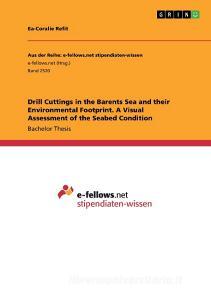
Drill Cuttings in the Barents Sea and their Environmental Footprint. A Visual Assessment of the Seabed Condition
- Editore:
GRIN Publishing
- EAN:
9783668505858
- ISBN:
3668505853
- Pagine:
- 76
- Formato:
- Paperback
- Lingua:
- Tedesco
Descrizione Drill Cuttings in the Barents Sea and their Environmental Footprint. A Visual Assessment of the Seabed Condition
Bachelor Thesis from the year 2016 in the subject Environmental Sciences, grade: 1,0, University of Kassel (Akvaplan-niva, Norway), language: English, abstract: The centre of interest for this Bachelor thesis is the visual assessment of drill cuttings at the sea floor around oil and gas drilling locations in the Barents Sea. The purpose is to detect the spatial extent of impacts on the sediments. In order to validate the reliability of visual assessments, the method is compared to the results of benthic macrofaunal analysis, which are an approved indicator of sea-floor assessments. The results of the visual assessment are also compared with Underwater Hyper-spectral Imaging (UHI), which is a tool under development for sea-floor assessments.In September 2015 six drilling sites of different age categories were investigated: recent (less than 8 weeks, post-drill), average (3 to 15 years) and old (more than 20 years). Video transects were carried out, and grab and core samples were obtained by a Remotely Operated underwater Vehicle (ROV). For sampling the UHI transects a push-broom scanner was attached to the ROV. The visual inspection of the video transects was recorded in a log file and plotted onto a geographical map.As a result of the different assessments the spatial extent of the impact of drill cuttings is for old (drilled before 1993's prohibition of discharging drill cuttings containing more than 1 % of oil) drilling sites of maximal 125 m, for average drilling sites of maximal 60 m and for recently drilled sites of maximal 250 m from the drill hole.In general, the visual assessment was mostly reliable (variance of about 10 m) to detect the spatial extent of impacts of drill cuttings. However, for locations drilled before 1993 the variance was higher, because natural sedimentation had occurred during the intervening period, and so the sediment surface did not always show the impacts which remained below the surface of the habitat. Thus visual assessments can be regarded as reliable for capturing visible depositions of drill cuttings, but at older sites additional validation will be needed to assess the full spatial extent of disturbance. The UHI analysis detects differences in a set of pre-defined categories of the surface sediment conditions, but the necessary software is still in development and not yet fully operational.

